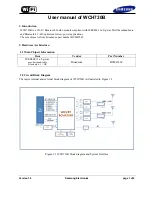
Wireless ADSL2
+
Router
HRDSL150W
User Manual
38
IP Address Mapping
(for Multiple IPs)
• Address Mapping Rule
: Shows the PVC where the rule will be applied to
• Rule Index:
Choose the rule number.
• Rule Type:
!
!
One-to-one: This is the mode maps one local IP address to one global IP address. Note that
port numbers do not change for the One-to-one NAT mapping type.
!
!
Many-to-One: This is the mode maps multiple local IP addresses to one global IP address.
This is equivalent to Many to One (i.e., PAT, port address translation).
!
!
Many-to-Many Overload: This mode maps multiple local IP addresses to shared global IP
addresses.
!
!
Many-to-Many No Overload: This mode maps each local IP address to an unique global IP
addresses.
!
!
Server: This type allows you to specify inside servers of different services behind the NAT to be
accessible to the outside world.
• Local Start IP:
This is the starting range for Inside Local IP Address (ILA). Local IP addresses are
N/A
for Server
port mapping.
• Local End IP:
This is the end range for Inside Local IP Address (ILA). If your rule is for all local IP
addresses, then enter 0.0.0.0 as the Local Start IP address and 255.255.255.255 as the Local End IP
address. This field is N/A
for One-to-one
and Server mapping types.
• Public Start IP:
This is the start range for Inside Public IP Address. Enter 0.0.0.0 here if you have a
dynamic IP address from your ISP.
• Public End IP:
This is the end range for Inside Public IP Address. This field is N/A for One-to-one,
Many-to-One
and Server mapping types.
NOTE:
Using port forwarding does have security implications, as outside users will be able to connect
to PCs on your network. For this reason you are advised to use specific Virtual Server entries just for
the ports your application requires, instead of using DMZ. As doing so will result in all connections from
the WAN attempt to access to your public IP of the DMZ PC specified.
Attention:
If you have disabled the NAT option in the WAN-ISP section, the Virtual Server function will
hence be invalid. If the DHCP server option is enabled, you have to be very careful in assigning the IP
addresses of the virtual servers in order to avoid conflicts. The easiest way of configuring Virtual
Servers is to manually assign static IP address to each virtual server PC, with an address that does not
fall into the range of IP addresses that are to be issued by the DHCP server. You can configure the
virtual server IP address manually, but it must still be in the same subnet as the router.
















































